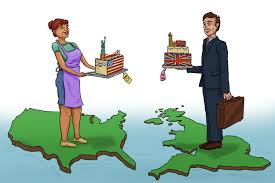
Mastering the Art of Trade: Navigating Global Markets with Confidence
The Art of Trade: A Vital Component of the Economy
Trade has been an integral part of human civilisation since ancient times. It is the exchange of goods and services between individuals, businesses, or countries, driven by the principles of supply and demand. The act of trading not only facilitates the movement of goods but also fosters economic growth and cultural exchange.
One of the key aspects of trade is its ability to create mutually beneficial relationships. By engaging in trade, individuals and businesses can access goods and services that they may not have otherwise been able to obtain. This exchange leads to specialization, where each party focuses on producing what they do best, resulting in increased efficiency and productivity.
Furthermore, trade plays a vital role in the global economy. Countries rely on international trade to expand their markets, access resources, and promote economic development. Through trade agreements and partnerships, nations can strengthen diplomatic ties and foster cooperation on a global scale.
Trade is not without challenges, however. Issues such as tariffs, trade barriers, and disputes can hinder the smooth flow of goods and services. It is essential for countries to engage in fair and transparent trade practices to ensure a level playing field for all parties involved.
In conclusion, trade is a dynamic force that drives economic growth, fosters innovation, and promotes cultural exchange. It is a cornerstone of modern society that continues to shape our interconnected world.
Understanding Trade: Definitions, Examples, and Types – A Comprehensive FAQ Guide
- What does mean trade?
- What is trade in explanation?
- What are examples of trade?
- What is trade examples?
- What is trade and types?
- What are the 3 types of trade?
- What do we mean by trade?
What does mean trade?
Trade refers to the exchange of goods and services between individuals, businesses, or countries. It is a fundamental economic activity driven by the principles of supply and demand. Through trade, parties engage in transactions to obtain products or services that they need or desire. Trade allows for the specialization of production, leading to increased efficiency and productivity. It plays a crucial role in shaping the global economy, facilitating the movement of goods across borders and fostering economic growth. Understanding the concept of trade is essential for navigating the complexities of modern commerce and international relations.
What is trade in explanation?
Trade, in simple terms, refers to the exchange of goods and services between individuals, businesses, or countries. It is a fundamental economic activity driven by the principles of supply and demand. Through trade, parties engage in transactions to acquire products they need or desire but may not produce themselves. This process of exchange fosters specialization, efficiency, and economic growth by allowing each party to focus on their strengths and benefit from the comparative advantages of others. Trade plays a crucial role in shaping the global economy and promoting cooperation and interdependence among nations.
What are examples of trade?
Trade encompasses a wide range of activities and transactions that involve the exchange of goods and services. Examples of trade include international exports and imports of goods such as electronics, automobiles, textiles, and agricultural products. Additionally, trade can involve the provision of services like consulting, transportation, tourism, and financial services across borders. Locally, trade occurs in retail settings where consumers purchase goods from supermarkets, shops, or online platforms. Trade is a fundamental aspect of the global economy, connecting individuals, businesses, and nations in a web of exchange that drives economic growth and development.
What is trade examples?
Trade examples encompass a wide range of scenarios where goods and services are exchanged between individuals, businesses, or countries. Some common examples of trade include international trade agreements between nations to facilitate the exchange of goods such as agricultural products, electronics, and automobiles. In a local context, trade examples can be seen in everyday transactions at markets or online platforms where consumers purchase goods like clothing, food items, or household appliances from retailers or suppliers. Trade examples demonstrate the fundamental principle of exchanging value for mutual benefit, driving economic growth and promoting global interconnectedness.
What is trade and types?
Trade refers to the exchange of goods and services between individuals, businesses, or countries. It is a fundamental economic activity that drives growth and development by allowing parties to access resources and products that they may not have domestically. There are several types of trade, including international trade, which involves the exchange of goods across borders; domestic trade, which occurs within a country’s boundaries; and e-commerce, which involves online transactions. Each type of trade plays a crucial role in shaping the global economy and fostering relationships between nations.
What are the 3 types of trade?
In the realm of trade, there are three primary types that define the exchange of goods and services: international trade, domestic trade, and entrepôt trade. International trade involves the buying and selling of goods and services across national borders, facilitating global economic integration. Domestic trade refers to the exchange of goods within a country’s own borders, supporting local economies and meeting domestic demand. Entrepôt trade, on the other hand, focuses on re-exporting imported goods to other countries without significant alteration, acting as a middleman in the global supply chain. Each type of trade plays a distinct role in shaping the interconnected web of global commerce.
What do we mean by trade?
Trade refers to the exchange of goods and services between individuals, businesses, or countries through buying and selling. It involves the transfer of products or services in return for something of value, such as money or other goods. Trade plays a crucial role in the global economy by facilitating the flow of goods and services across borders, driving economic growth, fostering specialisation, and promoting cultural exchange. In essence, trade is the foundation of commerce and a fundamental aspect of how societies interact and thrive economically.
